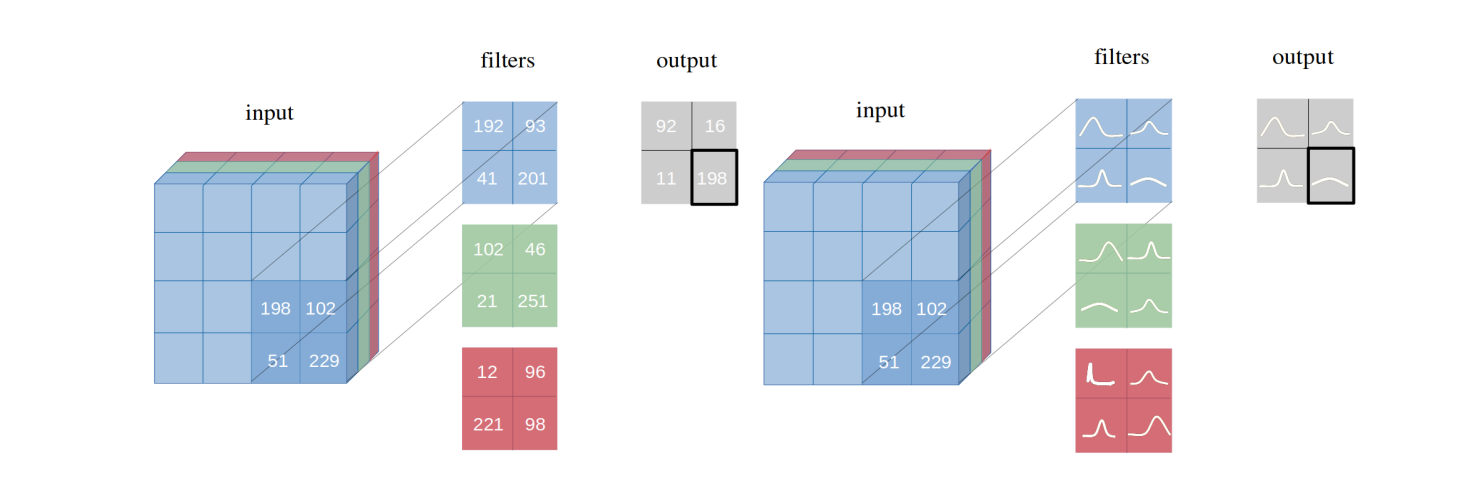A pytorch module to implement Bayesian neural networks with variational inference.
The standard layer implementation uses Bayes by Backprop [Blundell et al., 2015] and the local reparameterization trick [Kingma, Salimans and Welling, 2015] to accelerate the forward pass. The KL divergence is computed in closed form if possible, and using the Monte Carlo approximation otherwise.
Prior and posterior distribution can be set as arguments in the layer declaration. The module supports distributions from torch.distributions that have a loc and scale parameters. The default implementation uses a Normal posterior distribution as well as a Normal prior initialized with loc=0 and scale=1.
from torch.distributions import Normal
linear_layer = Linear(4, 5, posterior=Normal, prior=Normal(0, 1))This module is ment to be used as a drop-in replacement of torch.nn. Below is an example of a Bayesian neural network implementation.
import torch
import torch.nn as nn
import torch.nn.functional as F
import vinn
class Net(vinn.Module): # class Net(nn.Module):
def __init__(self):
super(Net, self).__init__()
self.conv1 = vinn.Conv2d(1, 6, 5) # self.conv1 = nn.Conv2d(1, 6, 5)
self.pool = nn.MaxPool2d(2, 2)
self.conv2 = vinn.Conv2d(6, 16, 5) # self.conv2 = nn.Conv2d(6, 16, 5)
self.fc1 = vinn.Linear(256, 120) # self.fc1 = nn.Linear(256, 120)
self.fc2 = vinn.Linear(120, 84) # self.fc2 = nn.Linear(120, 84)
self.fc3 = vinn.Linear(84, 10) # self.fc3 = nn.Linear(84, 10)
def forward(self, x):
x = self.pool(F.relu(self.conv1(x)))
x = self.pool(F.relu(self.conv2(x)))
x = x.view(-1, 256)
x = F.relu(self.fc1(x))
x = F.relu(self.fc2(x))
x = self.fc3(x)
return xBy default, vinn layers have a kl attribute returning the sum of the KL divergence between the layer prior and posterior approximation for each weight (and bias). Models extending vinn.Module have a kl attribute as well, it returns the sum of the KL divergence of each submodule in the model.
Bayesian neural networks implemented using variational inference can be trained by optimizing the Evidence Lower BOund (ELBO):
This is equivalent to minimizing the negative log likelihood (cross entropy loss) plus the KL divergence between the posterior approximation and the prior distribution. Such loss can be scaled to very large datasets using stochastic variational inference [Hoffman et al., 2013] as follows:
where i is the mini-batch index and M is the number of mini-batches. This can be implemented as follows:
net = Net()
criterion = nn.CrossEntropyLoss(reduction='sum')
optimizer = torch.optim.Adam(net.parameters(), lr=0.001)
beta = torch.tensor(1.0/len(data_loader))
for epoch in range(n_epochs):
for i, (inputs, targets) in enumerate(data_loader):
# zero the parameter gradients
optimizer.zero_grad()
# forward pass
outputs = net(inputs)
# build elbo loss
nll = criterion(outputs, targets)
kl = net.kl
elbo = nll + beta*kl
# backprop pass and optimize
elbo.backward()
optimizer.step()
⚠️ The negative log likelihood function (i.e.CrossEntropyLoss) must havereduction="sum"in order to follow the correct ELBO loss implementation. Otherwise,betaneeds to be scaled accordingly.
Since the parameters of the Bayesian model are sampled at each forward pass, every output corresponds to a sample from the predictive distribution. In order to estimate the predictive uncertainty it is possible to simply estimate the variance of the predictive distribution using such samples or, following [Kendall and Gal, 2017], compute both the aleatoric and epistemic components of uncertainty as follows:
Where T is the number of predictive samples, t is the sample index and i is the class index. Such uncertainty measure can finally be transformed into a more intuitive confidence score by computing c = 1 - 2*sqrt(u) as proposed in [Deodato et al., 2020].
def confidence_score(p):
"""
p: np.array of shape (n_predictive_samples, n_data_samples, n_classes)
"""
# compute sample mean
p_mean = np.mean(p, axis=0)
# compute uncertainty estimate
aleatoric = np.mean(p - np.square(p), axis=0)
epistemic = np.mean(np.square(p - p_mean), axis=0)
u = aleatoric + epistemic
# select uncertainty corresponding to the predicted class
u = u[np.arange(len(p_mean)), np.argmax(p_mean, axis=1)]
# return confidence score
return 1 - 2 * np.sqrt(u)[Blundell et al., 2015] "Weight Uncertainty in Neural Network". International Conference on Machine Learning.
[Deodato et al., 2020] "Bayesian Neural Networks for Cellular Image Classification and Uncertainty Analysis". bioRxiv.
[Hoffman et al., 2013] "Stochastic variational inference". The Journal of Machine Learning Research.
[Kendall and Gal, 2017] "What uncertainties do we need in bayesian deep learning for computer vision?". Advances in neural information processing systems.
[Kingma, Salimans and Welling, 2015] "Variational dropout and the local reparameterization trick". Advances in Neural Information Processing Systems.
